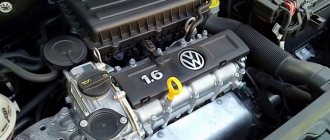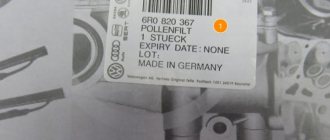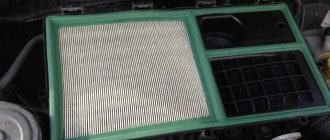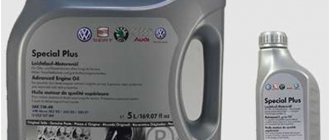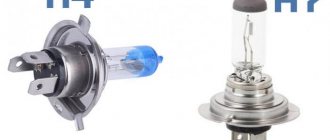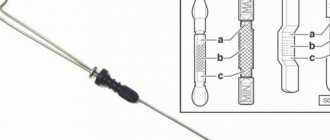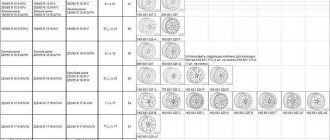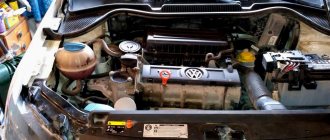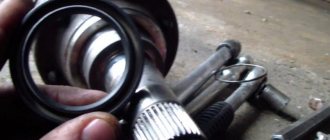The Volkswagen Polo has a wide range of engines installed in the engine compartment.
It includes three-cylinder and four-cylinder engines with different volumes and a wide spread of power.
The main thing that unites all Volkswagen Polo power plants is the absence of serious design flaws, high reliability and great durability of all engines.
The engines comply with environmental requirements and are characterized by low fuel consumption.
Three-cylinder engines that power the Volkswagen Polo
The Volkswagen Polo is powered primarily by gasoline engines. There are also options with a diesel engine. They have not found wide distribution in the domestic market. The volume of installed three-cylinder power units ranges from 1.0 to 1.4 liters.
The most economical petrol engine is the 1.0 TSI Blue Motion. Despite its liter volume, it produces decent performance. Its power is 95 horsepower.
At the same time, the engine develops a torque of 160 Nm. The manufacturer has modernized the power unit, resulting in 110 horsepower and 200 Nm of torque under the hood of the Volkswagen Polo. These figures are very respectable for a three-cylinder engine.
One of the small engines installed on the Volkswagen Polo is the in-line three-cylinder EA 111. This is a Czech engine, the design of which began in the mid-70s. The engine was migrated from the Audi 50, so it is practically free of childhood diseases. It has a displacement of 1.2 liters and produces 70 horsepower. Volkswagen Polo was equipped with this engine until 2014. New cars have more powerful internal combustion engines.
In 2009-2013, the three-cylinder turbo diesel 1.2 TDI BlueMotion gained wide popularity. The engine consumed up to 3.4 liters of diesel fuel per 100 kilometers. The engine was subsequently replaced with a more powerful 1.4 liter TDI BlueMotion. In 2016, the power unit was modernized, allowing it to remain competitive today.
Tuning options
Power units can be modified by removing environmental restrictions built into the ECM control program. This is done by flashing.
Installing turbines, replacing camshafts and other mechanical modifications can only be justified if you want to get individual engine settings. For higher power, it's quicker, easier and cheaper to purchase more advanced engine options, such as the unit supplied with the Polo GTI, which is capable of developing 180 or 190 hp. depending on the year of production. Or install a two-liter 2.0 TSI (2.0 WRC) internal combustion engine, developing 220 hp. and accelerating the car to 243 km/h, exchanging a hundred in 6.4 s.
Four-cylinder powertrains of the Volkswagen Polo
Most Volkswagen Polo sedan and hatchback cars are equipped with four-liter power units with engines ranging from 1.1 to 1.9 liters. The most popular engines were 1.4 and 1.6 liters.
A cheaper option is Volkswagen Polo cars with 1.6 liter engines. They have a power of 90 hp, 105 hp and 110 hp. Power plants have positive reviews from car owners. They are reliable and durable. The latest design upgrade was carried out in 2022. The most popular today is the 1.6-liter CFNA engine.
Unlike the domestic market, the 1.4 TSI engine is gaining popularity outside of it. It is the most dynamic. The operation of these power plants is accompanied by the need to use only high-quality fuel and synthetic motor oil.
Design
The structural differences of the CWVA from its predecessors (CFNA, CFNB) lie in the layout of the exhaust manifold with the cylinder head (now it is a single whole), equipping the intake camshaft with a phase shifter, a modified cooling system, changing the timing drive to a belt drive and an improved exhaust gas cleaning system.
Changes in the mechanical part of the internal combustion engine increased its power to 110 hp. s, and torque up to 155 Nm. At the same time, the unit has become more reliable in operation and easier to maintain, which is important for the Russian consumer. It is appropriate to note here that CWVA is not supplied to the European market, since it was developed specifically for the CIS market.
The engine is configured according to the MQB modular system. In other words, all motor components come in modules. In addition to simplifying the design, this approach significantly reduced the cost of producing the unit.
CWVA engine modules (without turbine and intercooler)
The cylinder block is made of aluminum alloy. Cast iron sleeves are mounted inside. Hon is applied to the working surfaces.
Aluminum pistons. Floating type piston pins. Secure with locking rings.
The connecting rods are steel, stamped.
The cylinder head is aluminum, with two camshafts and 16 valves. Compared to its predecessors, it has been rotated 180° (the inlet is located at the front). The valves do not require manual adjustment of the thermal gap, as they are equipped with hydraulic compensators. The exhaust manifold combined with the cylinder head ensures rapid heating of the catalyst, which in turn reduces the degree of pollution of the exhaust gases.
The timing belt is belt driven. The manufacturer determined the belt resource to be 120 thousand km. But experienced car enthusiasts and service station mechanics recommend inspecting the belt every 50-60 thousand km. At the same time, according to reviews from car owners, with proper operation and timely maintenance of the engine, the declared resource is significantly exceeded. The timing belt requires close attention, since if it breaks when it meets the pistons, the valves bend. And this is a serious and quite expensive engine repair.
The power system is injection type, with multi-point distributed fuel injection - MPI (Multi Point Injection). The peculiarity lies in the mandatory presence of a cooling circuit for the air-fuel mixture (structurally included in the engine cooling system). The need to solve the cooling issue is caused by a rather impressive difference in the temperatures of the injected gasoline and the upper part of the cylinder liner associated with the combustion chamber in the cylinder head. The cooling circuit prevents the occurrence of gas-air plugs. Another distinctive feature of the MPI internal combustion engine is the absence of a turbocharger.
The engine cooling system deserves special attention. The pump is of interest. It is made of plastic, has an individual drive and two thermostats. Despite its apparent fragility, it easily maintains 200 thousand km without breakdowns. Structurally, the pump is monoblock and cannot be repaired. The total service life is 8-9 years.
Water pump (pump) CWVA
Main technical characteristics
Volkswagen Polo has a wide range of engines used. The range of volumes of fuel consumed per 100 kilometers is from 3.4 to 12 liters. In real conditions, many car owners note an increase in fuel consumption up to 15-17 liters. In most cases, this is due to difficult road conditions or malfunctions in the car.
Fuel consumption according to the technical specifications for the most popular engines equipped with automatic and manual transmissions is shown in the table below.
The best acceleration performance is achieved by Volkswagen Polo cars, which have 1.4-liter power plants under the hood. This characteristic for popular Volkswagen Polo models is given in more detail in the table below.
Table - Acceleration to 100 km/h Volkswagen Polo
| Model | Acceleration to 10 km/h, seconds |
| 1.4 TSI MT | 9 |
| 1.4 TSI DSG | 9 |
| 1.2 TSI DSG Comfortline | 09.07.2018 |
| 1.6 MPI MT Comfortline | 10.04.2018 |
| 1.6 MPI MT Allstar | 11.04.2018 |
| 1.6 MPI AT Highline | 11.07.2018 |
| 1.6 MPI MT Conceptline | 11.09.2018 |
| 1.6 MPI AT Comfortline | 12.01.2018 |
| 1.8 GTI Cup Edition | 07.05.2018 |
| 1.8 GTI | 08.02.2018 |
| 1.9 TDI Trendline | 09.02.2018 |
| Volkswagen Polo 1.1 | 16 |
| Volkswagen Polo 1.0 | 19 |
Engine life
Many car enthusiasts are wary of three-cylinder engines. It is believed that their motor life is too short. Three-cylinder engines installed in the Volkswagen Polo can cover 300,000 kilometers before major overhaul. This figure is very impressive and debunks the idea of low durability of three-cylinder power plants.
Of the entire line of engines, the most reliable and durable is the 1.6-liter unit.
It is the least sensitive to fuel quality and maintenance compliance. For this reason, the Volkswagen Polo with a 1.6 engine has gained the greatest popularity in the domestic market. The engine life is 250-400 thousand km before major overhaul. According to reviews from car owners, the engines of cars produced in 2011-2012 are the most reliable.
The 1.4 TSI power units are characterized by the least reliability. They operate under high thermal load. The use of low-grade consumables or violation of maintenance intervals often leads to scoring on the cylinders. With proper treatment of the engine, its service life is about 230-250 thousand km.
CFNA oil
Engine oil volume: 3.6 l Recommended tolerance: VW 502 00, VW 504 00 The oil must comply with 502 approval, or the alternative 504 approval of the Volkswagen concern. The tolerance is indicated on the packaging, and it can also be checked on the oil manufacturer’s website
Recommended oil viscosity: 5W-40, 5W-30 . The factory fills it with 5W-30 Castrol EDGE Professional LongLife III , but there is an opinion that this brand of oil does NOT provide high engine protection. And certainly, you should not change this oil at intervals of 30 tkm. If you need engine durability, in our country you need to change the oil every 10 tkm maximum .
What kind of oil should I use?
Here are several brands of oil that meet VW 502.00 approval
- MOTUL Specific 502 505
- Shell Helix Ultra Extra 5W-30
- LIQUI MOLY Synthoil High Tech 5W-40
- Mobil 1 ESP Formula 5W-30
- ZIC XQ LS 5W30
Typical problems of power units
The most common problem, typical for the entire line of engines, is the presence of extraneous knocks during engine operation. The reason for this is the design feature of the pistons and the tightness of the intake manifold. A knocking sound appears after 20 thousand kilometers on a cold engine. Gradually, extraneous sounds begin to be present when the engine is warmed up.
The updated 1.6-liter engine with 110 horsepower received a timing belt and a plastic intake manifold. This brought shortcomings to the motor. Many car owners complain that cracks appear on the manifold and that the engine bends the valves when the belt breaks. The chain drive of the 105-horsepower unit is many times more reliable.
The most common power plant breakdowns that Volkswagen Polo car owners encounter are:
- sensor damage;
- cracks in the supports of the power unit;
- occurrence of piston rings;
- increase in crankcase gas pressure;
- The valve cover is sweating.
Service
Timely maintenance of the Volkswagen Polo sedan engine significantly extends its service life and allows it to be increased to 500 thousand kilometers.
Basically it comes down to regular computer diagnostics and replacement (after every 15 thousand km of travel):
- motor oil;
- oil filter;
- oil pan plugs.
In addition, every 30,000 km it is recommended:
- replace the air filter;
- Pay attention to the spark plugs and replace them if necessary.
The feasibility of repair and replacement with a contract motor
When the power plant completely exhausts its resource, the car owner is presented with many options to revive his car. Some of them are:
- superficial engine repair;
- major overhaul of the power plant;
- purchase of a contract motor;
- purchasing an engine from a domestic car wrecker.
As a result of superficial engine repairs, problems that interfere with engine performance are eliminated. At the same time, breakdowns occur at regular intervals, since most of the elements have exhausted their service life.
The cost of such repairs is no more than 10,000 rubles. This type of restoration is recommended only in case of the next sale of the machine or in case of irregular use of it.
Major repairs allow you to restore up to 70-85% of the service life of a new unit. It is recommended to carry out it in the absence of difficult to eliminate consequences of operating the power plant. The cost of major repairs is about 30-50 thousand rubles.
Purchasing a contract engine from a foreign dismantling site is one of the radical ways to solve problems with the exhaustion of the power plant's resource. The price of such a motor ranges from 20 to 60 thousand rubles. It is quite difficult to estimate the residual life when purchasing an engine. It is worth noting that among the contract power plants there are quite a lot of units capable of covering 70-120 thousand km without serious financial investments for repairs. The photo below shows a typical engine from a foreign car wrecker.
Purchasing a motor at domestic car dismantling yards is quite a risky endeavor. In most cases, it is impossible to know the actual mileage, since it is repeatedly twisted, passing through the hands of intermediaries. Therefore, you can purchase a used engine from domestic car dismantling yards only after a personal inspection with a familiar auto mechanic or motor mechanic. The cost of such a unit is 15-35 thousand rubles.
Wear resistance of Hyundai Solaris
Of course, the so-called factory resource is very different from the actual one. And if one driver can easily drive a Hyundai for 200, or even 300 thousand km, then another will manage to kill the engine in 50.
The situation is aggravated by the fact that for the engine of this model there is no such thing as a major overhaul. If there is no proper care for it, you will simply have to replace it with a new one, paying at least 50 thousand rubles for this pleasure.
The problem is that the manufacturer does not produce spare parts for many motor elements. If aluminum pistons or cylinder walls fail, there will be nothing to replace them with.
Recommendations for choosing a Volkswagen Polo car with various power plants
According to reviews from car owners, it is best to purchase a Volkswagen Polo with a 1.6-liter gasoline engine. The most modern engine has 110 horsepower. This is quite enough for comfortable driving both in heavy traffic and on the highway. The motor is not whimsical and has a good resource.
If the car owner’s priority is the car’s dynamics, then you should take a closer look at the 1.4 TSI petrol engine or 1.9 liter diesel engine. They have excellent technical characteristics and are able to provide a sporty driving style for the driver.
For those who want to save on fuel, there are three-cylinder versions. It should be borne in mind that you should not expect good dynamics from a 1.0-1.2 liter power plant. Despite this, the low power engine will not cause problems when driving in city traffic.
